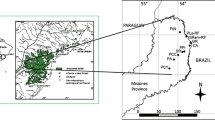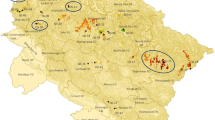Abstract
Assessment of genetic variation within and among populations is an essential parameter for the effective conservation of forest genetic resources. In this work, the genetic diversity within and among natural populations of the forest tree species Fraxinus angustifolia Vahl in Greece was studied using selected nuclear and chloroplast microsatellite DNA loci. Eight natural populations of F. angustifolia were identified in different locations of the mainland of Greece, and a total of 230 individuals were studied. High polymorphism was observed within populations, while the genetic differentiation among populations was moderate. Intra-population diversity was correlated with geographical coordinates, but no isolation by distance was observed. Of the three haplotypes identified, only one was dominant. Putative ancestral haplotypes were found at small spatial scales suggesting that population expansions could have originated in the region. This study located in sympatry haplotypes that in other parts of Europe are in allopatry, reinforcing the notion of population expansions from the south of Balkans including Greece. Suggestions for conservation and management of F. angustifolia are also reported.




Similar content being viewed by others
References
Boshier DH, Young AG (2000) Forest conservation genetics: limitations and future directions. In: Young AG, Boshier DH, Boyle T (eds) Forest conservation genetics: principles and practice. CSIRO Publishing, Australia
Bottin L, Verhaegen D, Tassin J, Olivier I, Vaillant A, Bouvet MJ (2005) Genetic diversity and population structure of an insular tree, Santalum austrocaledonicum in New Caledonian archipelago. Mol Ecol 14:1979–1989
Brachet S, Jubier MF, Richard M, Junc-Muller B, Frascaria-Lacoste N (1999) Rapid identification of microsatellite loci using 5′ anchored PCR in the common ash Fraxinus excelsior. Mol Ecol 8:160–163
Brookfield JFY (1996) A simple new method for estimating null allele frequency from heterozygote deficiency. Mol Ecol 5:453–455
Chakraborty R, De Andrade M, Daiger SP, Budowle B (1992) Apparent heterozygote deficiencies observed in DNA typing data and their implications in forensic applications. Ann Hum Genet 56:45–57
Cho KJ, Chung JM, Kim WW, Hong YP (2002) Genetic structure analysis of three Fraxinus species populations in Korea. Paper presented at the ‘Genetics’ Symposium, Stará Lesná, Slovakia
Cornuet JM, Luikart G (1996) Description and power analysis of two tests for detecting recent population bottlenecks from allele frequency data. Genetics 144:2001–2014
Fady-Welterlen B (2005) Is there really more biodiversity in Mediterranean forest ecosystems? Taxon 54:905–910
FAO (1995) Collecting woody perennials. In: Guarino L, Rao R, Reid R (eds) Collecting plant genetic diversity: technical quidelines. CAB International, Wallingford, pp 485–509
Felsenstein J (2007) PHYLIP: Phylogeny inference package, version 3.67c, Department of Genome Sciences and the Department of Biology, University of Washington, Seattle
Fernandez-Manjarres JF, Gerard PR, Dufour J, Raquin C, Frascaria-Lacoste N (2006) Differential patterns of morphological and molecular hybridization between Fraxinus excelsior L. and Fraxinus angustifolia Vahl (Oleaceae) in eastern and western France. Mol Ecol 15:3245–3257
Ferrazzini D, Monteleone I, Belletti P (2007) Genetic variability and divergence among Italian populations of common ash (Fraxinus excelsior L.). Ann For Sci 64:159–168
FRAXIGEN (2005) Ash species in Europe: biological characteristics and practical guidelines for sustainable use. Oxford Forestry Institute, Department of Plant Sciences, University of Oxford, Oxford
Gebremedhin B, Ficetola GF, Naderi S, Rezaei HR, Maudet C, Rioux D, Luikart G, Flagstad O, Thuiller W, Taberlet P (2009) Frontiers in identifying conservation units: from neutral markers to adaptive genetic variation. Anim Conserv 12:107–109
Goudet J (2001) FSTAT, a program to estimate and test gene diversities and fixation indices (version 2.9.3). Available from http://www.unil.ch/izea/softwares/fstat.html
Hardy OJ, Vekemans X (2002) SPAGeDi: a versatile computer program to analyse spatial genetic structure at the individual or population levels. Mol Ecol Notes 2:618–620
Hartl DL, Clark AG (1989) Principles of population genetics. Sinauer Associates, Sunderland
Heuertz M, Hausman J, Tsvetkov I, Frascaria-Lacoste N, Vekemans X (2001) Assessment of genetic structure within and among Bulgarian populations of the common ash (Fraxinus excelsior L.). Mol Ecol 10:1615–1623
Heuertz M, Fineschi S, Anzidei M, Pastorelli R, Salvini D, Paule L, Frascaria-Lacoste N, Hardy OJ, Vekemans X, Vendramin GG (2004a) Chloroplast DNA variation and postglacial recolonization of common ash (Fraxinus excelsior L.) in Europe. Mol Ecol 13:3437–3452
Heuertz M, Hausman JF, Hardy OJ, Vendramin GG, Frascaria-Lacoste N, Vekemans X (2004b) Nuclear microsatellites reveal contrasting patterns of genetic structure between western and southern European populations of the common ash (Fraxinus excelsior L.). Evolution 58:976–988
Heuertz M, Carnevale S, Fineschi S, Sebastiani F, Hausman F, Paule L, Vendramin GG (2006) Chloroplast DNA phylogeography of European ashes, Fraxinus sp. (Oleaceae): roles of hybridization and life history traits. Mol Ecol 15:2131–2140
Holderegger R, Kamm U, Gugerli F (2006) Adaptive vs. neutral genetic diversity: implications for landscape genetics. Landscape Ecol 21:797–807
Hu LJ, Uchiyama K, Shen HL, Saito Y, Tsuda Y, Ide Y (2008) Nuclear DNA microsatellites reveal genetic variation but a lack of phylogeographical structure in an endangered species, Fraxinus mandshurica, across north-east China. Ann Bot 102:195–205
Jarne P, Lagoda PJL (1996) Microsatellites, from molecules to populations and back. Trends Ecol Evol 11:424–429
Jeandroz S, Frascaria-Lacoste N, Bousquet J (1996) Molecular recognition of the closely related Fraxinus excelsior and F. oxyphylla (Oleaceae) by RAPD markers. Forest Genet 3:237–242
Lefort F, Brachet S, Frascaria-Lacoste N, Edwards KJ, Douglas GC (1999) Identification and characterization of microsatellite loci in ash (Fraxinus excelsior L.) and their conservation in the olive family (Oleaceae). Mol Ecol 8:1088–1089
Lowe A, Harris S, Ashton P (2004) Ecological genetics—design, analysis, and application. Blackwell, UK/USA/Australia
Morand ME, Brachet S, Rossignol P, Dufour J, Frascaria-Lacoste N (2002) A generalized heterozygote deficiency assessed with microsatellites in French common ash populations. Mol Ecol 11:377–385
Morgante M, Olivieri AM (1993) PCR-amplified microsatellites as markers in plant genetics. Plant J 3:175–182
Mueller-Starck G (1989) Genetic implications of environmental stress in adult forest stands of Fagus sylvatica L. In: Scholz F, Gregorius H, Rudin D (eds) Genetic effects of air pollutants in forest tree populations. Springer, Berlin, pp 127–142
Nei M (1978) Estimation of average heterozygosity and genetic distance for small number of individuals. Genetics 89:583–590
Nei M (1987) Molecular evolutionary genetics. Columbia University Press, New York
Newton AC, Allnutt TR, Gillies ACM, Lowe AJ, Ennos RA (1999) Molecular phylogeography, intraspecific variation and the conservation of tree species. Trends Ecol Evol 14:140–145
Payn KG, Dvorak WS, Janse BJH, Myburg AA (2008) Microsatellite diversity and genetic structure of the commercially important tropical tree species Eucalyptus urophylla, endemic to seven islands in eastern Indonesia. Tree Genet Genome 4:519–530
Petit R, El Mousadik A, Pons O (1998) Identifying populations for conservation on the basis of genetic markers. Conserv Biol 12:844–855
Petit RJ, Aguinagalde I, de Beaulieu JL, Bittkau C, Brewer S, Cheddada R, Ennos R, Fineschi S, Grivet D, Lascoux M, Mohanty A, Müller-Starck GM, Demesure-Musch B, Palmé A, Martin JP, Rendell S, Vendramin GG (2003) Glacial refugia: hotspots but not melting pots of genetic diversity. Science 300:1563–1565
Petit R, Hampe A, Cheddadi R (2005) Climate changes and tree phylogeography in the Mediterranean. Taxon 54:877–885
Piry S, Luikart G, Cornuet JM (1999) BOTTLENECK: a computer programme for detecting recent reductions in the effective population size using allele frequency data. J Hered 90:502–503
Rameau JC, Mansion D, Dume G (1989) Flore forestiere Francaise, guide ecologique illustre. Tome I Plaines et Collines Institute pour le Developpement Forestier, Paris
Ritland K (1990) A series of FORTRAN computer programs for estimating plant mating systems. J Heredity 81:235–237
Ritland K (2002) Extensions of models for the estimation of mating systems using n independent loci. Heredity 88:221–228
Rousset F (1997) Genetic differentiation and estimation of gene flow from F-statistics under isolation by distance. Genetics 145:1219–1228
Rousset F (2008) GENEPOP’007: a complete reimplementation of the GENEPOP software for Windows and Linux. Mol Ecol Notes 8:103–106
Spanos K, Papi R, Mylonas D, Gaitanis D, Kyriakidis D (2004) The European research programme FRAXIGEN: ash for the future, defining ash populations for conservation, regeneration and ecological adaptation—works in Greece. In: Forest genetics and tree breeding in the age of genomics: progress and future. Proceedings of a joint conference of IUFRO Division 2 Charleston, South Carolina, USA, pp 421–429
Tutin TG, Heywood VH, Burges NA (1972) Flora Europaea. Cambridge University Press, Cambridge
van Oosterhout C, Hutchinson WF, Wills DPM, Shipley P (2004) MICRO-CHECKER: software for identifying and correcting genotyping errors in microsatellite data. Mol Ecol Notes 4:535–538
Vendramin GG, Morgante M (2005) Genetic diversity in forest tree populations and conservation: analysis of neutral and adaptive variation. In: The role of biotechnology, Villa Gualino, Turin, Italy—5–7 March, 2005, pp 129–130
Wallander E (2001) Evolution of wind-pollination in Fraxinus (Oleaceae)—an ecophylogenetic approach. Göteborg University, Göteborg
Wallander E, Albert VA (2000) Phylogeny and classification of Oleaceae based on rps16 and trnl-F sequence data. Am J Bot 87:1827–1841
Weir BS, Cockerham CC (1984) Estimating F-statistics for the analysis of population structure. Evolution 38:1358–1370
Weising K, Gardner RC (1999) A set of conserved PCR primers for the analysis of single sequence repeat polymorphisms in chloroplast genomes of dicotyledonous angiosperms. Genome 42:9–19
Acknowledgments
This work was financially supported by FRAXIGEN (EVK2-CT-2001-00180), funded by FP5 of EU. The authors would like to thank Dionysios Gaitanis and Dimosthenis Mylonas for collecting plant material and field work.
Author information
Authors and Affiliations
Corresponding author
Additional information
Communicated by R. Matyssek.
Rights and permissions
About this article
Cite this article
Papi, R.M., Spanos, K.A. & Kyriakidis, D.A. Genetic variation of Fraxinus angustifolia natural populations in Greece based on nuclear and chloroplast microsatellite markers. Eur J Forest Res 131, 1151–1161 (2012). https://doi.org/10.1007/s10342-011-0586-1
Received:
Revised:
Accepted:
Published:
Issue Date:
DOI: https://doi.org/10.1007/s10342-011-0586-1




